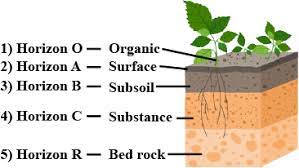Soil profile is a vertical section of soil that provides information about the different layers or horizons of soil and their physical and chemical properties. Understanding the soil profile is crucial for agriculture, forestry, and land management as it helps in determining the best use of the land for different purposes. In this article, we will discuss the various components of the soil profile and their significance.

Table of Contents
Components of the Soil Profile
The soil profile is composed of several distinct horizons or layers, each with its own unique characteristics. The following are the major components of the soil profile:
- O Horizon: This is the topmost layer of the soil profile and is composed of organic matter such as leaves, twigs, and other plant material.
- A Horizon: This is the topsoil layer and is composed of organic matter mixed with minerals. It is rich in nutrients and is where most plant roots grow.
- B Horizon: This layer is also known as the subsoil and is composed of minerals that have been leached from the topsoil. It is less fertile than the A horizon.
- C Horizon: This layer is the parent material from which the soil has formed and is composed of weathered rock fragments.
- R Horizon: This is the solid rock layer and is the underlying layer of the soil profile.
Significance of the Soil Profile
The soil profile provides information about the different layers of soil and their physical and chemical properties, which is crucial for the following:
- Agriculture: The soil profile helps in determining the fertility of the soil, the type of crops that can be grown, and the methods of soil management that are needed for optimal crop production.
- Forestry: The soil profile helps in determining the suitability of the land for forestry and in managing the forest ecosystem.
- Land Management: The soil profile helps in determining the best use of the land, such as for agriculture, forestry, or urban development.
- Environmental Monitoring: The soil profile helps in monitoring soil degradation and the impact of human activities on the soil.
- Geology: The soil profile provides information about the geology of the area, including the composition of the underlying rock and the processes of soil formation.
Conclusion
The soil profile is a crucial aspect of soil science and provides important information about the different layers of soil and their physical and chemical properties. Understanding the soil profile helps in determining the best use of the land for different purposes and in managing the land for sustainable agriculture, forestry, and land management. By understanding the soil profile, we can take better care of this valuable natural resource and ensure its health and productivity for future generations.
Important Links